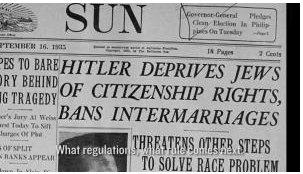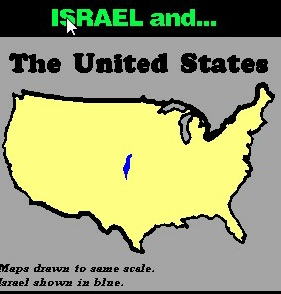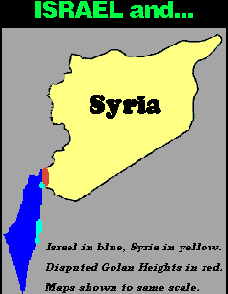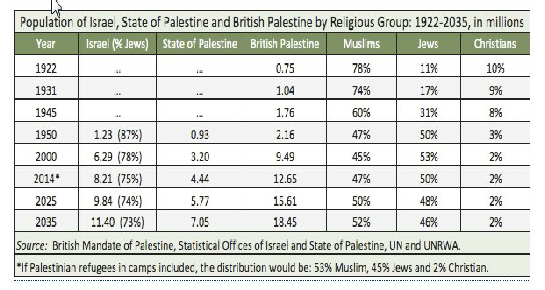|
PART 1 T O P I C |
|
|
|
|
|
|
|
|
|
|
|
|
|
|
|
|
|
|
JewishWikipedia.info
|
|
|
|
|
CLICK BUTTON |
|
|
|
|
|
|
|
|
|
Israel |
|
|
|
|
|
|
|
ISRAEL - PALESTINIAN |
|
|
|
|
|
|
Israel is a tiny country of 8,359 Sq miles, the West Bank is 2,262 sq miles, the Golan Heights is 444 sq miles and Gaza is 100 sq miles. The USA is 3,794,083 sq. Miles -
That is Israel is .002% the size of the USA. Click here for comparison maps.
WHAT IT WAS LIKE
“ ...[a] desolate country whose soil is rich enough, but is given over wholly to weeds-a silent mournful expanse....A desolation is here that not even imagination can grace with the pomp of life and action....We never saw a human being on the whole route....There was hardly a tree or a shrub anywhere. Even the olive and the cactus, those fast friends of the worthless soil, had almost deserted the country.”
- 1867 (Quoted in Mark Twain, The Innocents Abroad. London: 1881)
TODAY, ISRAEL IS A TINY COUNTRY
WITH A POPULATION SIMILAR TO LONDON
POPULATION OF ISRAEL
Wikipedia
The demographic features of Israel are monitored by the Israel Central Bureau of Statistics. The State of Israel has a population of approximately 8,585,000 inhabitants as of September 2016. 74.8% percent of them are Jews (about 6,419,000 individuals), 20.8% are Arab (about 1,786,000 individuals), while the remaining 4.4% (about 380,000 individuals) are defined as "others" (including family members of Jewish immigrants who are not registered at the Ministry of Interior as Jews, non-Arab Christians, non-Arab Muslims and residents who do not have an ethnic or religious classification).
Israel's annual population growth rate stood at 2.0% in 2015, more than three times faster than the OECD average of around 0.6%. With an average of 3 children per woman, Israel also has the highest fertility rate in the OECD by a considerable margin, and much higher than the OECD average of 1.7
Generally, population trends in Israel reflect distinct patterns of three sub-groups: Non-Haredi Jews (around 63.3% of the population), Haredi (strictly Orthodox or ultra-OrthodoxJews) (11.7%), and Arabs (20.7%). Over the past decade, the Muslim annual population growth has fallen significantly from around 3% to less than 2.2% by 2013, while the overall Jewish growth rate rose from around 1.4% to 1.7%, primarily due to the expanding Haredi sector.
See Also Can’t the Israeli-Palestinian Conflict Be Resolved? by Joseph Chamie • March 11, 2015 • WORLDVIEWS
After the failure of United States mediated peace talks, the Gaza-Israel war and the recent tensions in Jerusalem, the prospects for a near-term settlement to the Israeli-Palestinian conflict have reached an all-time low. Given those conditions, it is useful and perhaps productive to revisit and reconsider the fundamental solutions for resolving the conflict. Numbers, too, help to understand the situations in the region.
This looks at the alternative One-state solution, Two-state solution.Three-state solution, No Palestinian-state solution, No Israel-state solution, Prospects
ISRAEL’S POPULATION TOPS 9 MILLION
AS JEWISH NEW YEAR APPROACHES
Times of Israel 20 September 2019
Israel’s population tops 9 million as Jewish new year approaches
Population expected to reach 10 million by 2024; Jewish Agency says 14.8 million Jews worldwide, a slight increase from last year
Israel’s population stands at 9,092,000 and is expected to reach 10 million by Rosh Hashanah 2024, the Central Bureau of Statistics said on Thursday.
n figures published ahead of the Jewish new year which begins Sunday evening, the CBS said the country’s 6.744 million Jews make up 74.2 percent of the total population, and its 1.907 million Arabs represent 21%.
Other minority groups comprise 4.8 percent of the population with 441,000 residents.
Since Rosh Hashanah 2018, the population rose by 184,000, marking a 2.1% increase, a similar change to previous years. Israelis gave birth to 196,000 children in the past year, while 50,000 citizens died. Some 38,000 people moved to the country, of whom 35,000 were Jewish immigrants who received citizenship.
At its current pace, the Jewish State will have 15 million residents by its hundredth birthday in 048 and 20 million by 2065, the report said.
Worldwide, there are now 14.8 million Jews, a slight increase from the 14.7 million tallied the year before, the Jewish Agency reported on Thursday.
There are 8.1 million Jews living outside Israel, with the largest population in the United States, which has 5.7 million Jews.
Following Israel and the US, the countries with the largest number of Jews are France (450,000), Canada (392,000), Britain (292,000), Argentina (180,000), Russia (165,000), Germany (118,000) and Australia (118,000).
The Jewish Agency says there 26,000 Jews living in Arab and Muslim states, with 15,000 in Turkey, 8,500 in Iran, 2,000 in Morocco and 1,000 in Tunisia.
The statistics are based on self-identification as Jewish and not as any other religion. The Jewish Agency said when looking at those eligible to get citizenship under Israel’s Law of Return, which requires at least one Jewish grandparent, there are 23.6 million Jews worldwide.

BY 2035, JEWISH POPULATION IN ISRAEL/PALESTINE
IS PROJECTED AT 46 PERCENT
Mondoweiss Joseph Chamie on February 21, 2014
ted daily about the current American-initiated Israeli-Palestinian peace negotiations. However, comparatively little attention — and, hence, insufficient understanding — is given to a critical aspect of the decades-old conflict: population growth. Differential rates of population growth are redefining the relative demographic standing of Arab-Israelis, Jewish-Israelis and Palestinians in the region, pointing to a challenging demographic future for the Jewish-Israeli majority and affecting key negotiating concerns, positions and strategies, including establishing borders, the status of settlements and the return of Palestinian refugees.
The tract of land at the center of the conflict — the former British Mandate of Palestine – is relatively small. The combined surface area of Israel and the State of Palestine (the Gaza Strip plus the West Bank) is about the size of Haiti and can be fit into Texas about 25 times. The relative proportions of this combined territory are 79 percent Israel and 21 percent Palestine territory (20 percent West Bank and 1 percent Gaza Strip).
The total number of people residing in this tract is also not large. Fewer than 13 million — numerically equivalent to 4 percent of the US population — live there. As is widely acknowledged, the central defining characteristic of this population is its religious affiliation. A brief look at the past provides insight into the demographic status and growth of the major religious groups in this troubled land.
With the establishment of the British Mandate of Palestine after World War I, the first British census of Palestine in 1922 enumerated a total population of about 750,000, of which 78 percent were Muslim, 11 percent Jewish and 10 percent Christian (Table 1). Nearly 25 years later, before the United Nations’ partition of the Mandate for Palestine, in 1947, the population had grown to nearly 1.8 million, with 60 percent Muslim, 31 percent Jewish and 8 percent Christian.
The estimated 1950 population residing in the former British Mandate of Palestine exceeded 2 million, representing an almost equal balance of Jews (50 percent) and Muslims (47 percent) and Christians, shrinking to 3 percent (Table 1). Because of different rates of population growth among the religious groups, especially with large-scale immigration, the Jewish proportion of this combined population continued to increase throughout the second half of the 20th century.
At the start of the 21st century, the Jewish proportion peaked at 53 percent, followed by Muslims at 45 percent and Christians at 2 percent. Today, the Jewish proportion represents half of the resident population in Israel and the State of Palestine. However, if Palestinian refugees living in camps in neighboring countries are taken into account, the majority of the population, 53 percent, would be Muslim.
In 1947, Mandatory Palestine was partitioned by the UN General Assembly into two states, one Jewish and the other Arab. Three years later, the population of Israel increased to 1.3 million, with 87 percent being Jewish Israelis. The population of Palestinians living in the State of Palestine (the Gaza Strip and West Bank) was slightly less than a million. Additionally, an estimated 500,000 Palestinians were displaced as a result of war in nearby countries, mainly to Jordan, Lebanon and Syria.
Because of high levels of Jewish immigration to Israel, especially from the former Soviet Union, as well as high birth rates, the population of Israel grew to more than 6 million by the close of the 20th century, but the proportion of Jewish people declined to 78 percent, a 9 percentage-point drop from 1950. In contrast, the demographic growth rate of Palestinians fluctuated considerably during this period, a result of wars and further civilian displacements.
At the end of the century, the Palestinian population living in the State of Palestine reached slightly more than 3 million, with at least an additional half million Palestinians living in refugee camps in neighboring countries and more than two million residing outside camps.
The population of Israel in 2014 is approximately 8.2 million, about the same size as New York City, with 75 percent of the population being Jewish Israelis. The Israeli population is growing at about 1.8 percent a year. Although relatively low in comparison to the rates of the 1990s, Israel’s current demographic growth is double the rate of the United States and many times greater than Europe’s. The median age of the Israeli population is 30 years old, which is about 15 years younger than the average ages in Germany, Italy and Japan. Israel’s fertility rate is about 3 children for every woman, again well above the average for most developed countries.
This comparatively high birth rate, however, has not deterred women from pursuing higher education. In fact, women account for the majority, 56 percent, of college students in Israel.
Immigration contributed greatly to the rapid growth of Israel’s Jewish population, but today it is estimated that more than half — about 58 percent — of the world’s Jewish population lives outside Israel, mainly in the US, at about 40 percent, followed by France, Canada and Britain, each under 4 percent. As large-scale Jewish emigration from these developed countries to Israel is considered unlikely, most of Israel’s current and future demographic growth will be the result of natural increase.
The population of Palestinians in the State of Palestine in 2014 is about 4.4 million, with 1.7 million in the Gaza Strip and 2.7 million in the West Bank. According to the UN Relief and Works Agency, which is responsible for the care of Palestinian refugees, more than 1.5 million Palestinian refugees are living in camps in countries in the region. The number of Palestinian refugees in neighboring countries but living outside refugee camps is estimated at approximately 4 million.
The Palestinian population living in the State of Palestine is growing comparatively fast, 2.4 percent a year, or 33 percent higher than Israel’s current rate of population growth. The population is also young, with half 18 years old or under, making it the youngest population in the region. Although Palestinian fertility has declined substantially from a record high of about 8 children per woman in the 1960s, it remains comparatively high at more than 4 children for every woman.
As noted in the case of Israel, even with high birth rates Palestinian women actively pursue higher education, constituting the majority, 56 percent, of college students.
Population projections for the next 20 years indicate continued demographic growth for both Israel and the State of Palestine. The Palestinian population is expected to grow more rapidly than the Israeli population because of higher fertility rates. Whereas the Israeli population is expected to increase by about 40 percent by 2035, the Palestinian population is projected to increase by nearly 60 percent (Table 1).
Population projections also show that while the Jewish proportion in Israel will decline slightly over the next two decades, it will continue to be the dominant majority of the Israeli population, 73 percent in 2035. This is not the case, however, when one considers the entire future population residing in the former British Palestine. Demographic projections indicate that less than half of the future population residing there would be Jewish, 48 percent in 2025 and 46 percent by 2035. But if only the West Bank population were to be incorporated into Israel, the Jewish proportion would be a declining majority, 57 percent in 2014 to 53 percent by 2035.
Given the many contentious issues, powerful interests and past failed attempts, a successful outcome of the current Israeli and Palestinian negotiations is at best uncertain. Yet, at least one issue remains clear: Whatever future comprehensive peace agreement eventually arises, be it a one-state, two-state or three-state solution with agreed upon territorial and population swaps or something else, the population growth of the major religious groups residing in this troubled land will continue to have significant consequences that will reverberate well beyond its boundaries, just as it has in the recent past.
This piece first appeared at Pass Blue, a CUNY site covering the UN, with the headline
“Israeli-Palestinian Population Growth and Its Impact on Peace.”
THE JEWISH ENIGMA
The Jewish Enigma’ by Robin Spiro -
Editor David Englander, The Open University 1992)
Jewish Enigma makes the following points between 1300 and 1800
- The total for the Jewish population in Europe in 1800 of over 2,000,000 hides the extraordinary geographical movements that had taken place since the fourteenth century. A virtually non-existent Jewish community in eastern Europe had now become by far the largest in the world, whereas the Jews of western Europe had been reduced from 30% of world Jewry to less than 4%.
- While the Jewish population of eastern Europe increased from about 5,000 to 1.5 million during these five centuries, the size of the general population increased from some 20 million to just over 50 million. The enormous disparity can be explained by migrations from both the west and the south-east and by both a higher rate of birth and a lower rate of child mortality.
- In 1300 a world Jewish population of approximately 950,000 was made up of about half a million living in Islamic countries in the Middle East and about 450,000 living in Europe. In 1800, while the European Jewish population had increased to nearly 2.5 million, the number of Jews in the Middle East had remained static at about 500,000
The Wikipedia statistics show the massive movement to the Americas, the increase in Asia due to the immigration into Palestine and then Israel after it was created in 1948. In Africa the fall was largely due to the movement from South Africa.
The Jewish Enigma' poses the following question (see bottom of p45 on)
- How have the Jews been able to survive as a people for over two millennia - much of that time dispersed, without a land and often beset by enemies determined to oppress, if not destroy, them?
It is perhaps worth reviewing, some of the factors that have already been mentioned to see whether any clues suggest themselves. Needless to say, no definitive answers can be given to such a profound and complex question within the context of such a brief historical review
- Until recent times, it was acknowledged that, first and foremost, rabbis and scholars who knew and could interpret Jewish law were an integral component of the community’s leadership. Jews were taught that the guardians of a city were not the soldiers or magistrates, but those who taught the Bible and Mishna and instructed in Halakha. This implied a certain set of priorities.
Until the emancipation, the Jewish community was recognized as a separate legal entity by the state’s ruler, and thereby had the authority to compel its members to obey. Yet the mechanisms of enforcement, the harshest being the Herem, the Ban of Excommunication, were very rarely used. The main means of coercion were public opinion and communal pressure. As long as the King acknowledged the community’s right to self-government, its members complied with its rulings as if there were a local government. The rabbis, being both the instructors and the judges of the community, exerted a very strong influence. Yet in most communities the public and the lay leadership - usually the well-off members - were able to restrain the more extremist rabbis and prevent them from unpopular Halakhic decisions.
- Again, rabbinical leaders could emerge from any social background, for religious education was available to all boys and the rigid class distinctions of other societies were less in evidence. The Jewish religious practices and public prayers maintained an intensive communal life. This was not just a question of Jewish tradition, but was also partly a result of the precariousness of Jewish existence as a religious minority and an ethnic group.
- The value placed on human life by Jews in different circumstances is itself worthy of note. On the one hand, in times of persecution Jewish tradition expected that every man, woman and child be prepared to accept death rather than conversion. On the other hand, one of the most crucial decisions made by the rabbis was the edict preventing unnecessary loss of life after the slaughter of Jews during the revolts against Rome. Jews were obliged to risk their lives in cases of idol worshiping, the shedding of blood and sexual promiscuity. This law ensured the survival of the Jewish community beyond the period of persecutions. Jews were aware of the importance of their remaining alive to practise Judaism and pass it on to their children. As the Psalmist wrote: ‘The dead cannot praise the Lord, nor any who go down into silence’
- Judaism did hold the promise of the hereafter for every pious Jew. But it also always encouraged the struggle to improve life in this world, coupled with a determination not to accept the ‘status quo’ if existing conditions inhibited social progress. In this connection, it should be realized that Jewish communities became highly organized, not only for education but also for social welfare. The less fortunate - the widow, the orphan, and the sick - all became the responsibility of relevant local communities. Communal bodies looked after the various needs their members and provided help for the needy, burial and, of course, education. Social cohesion and mutual support were encouraged, and it was considered a sin for a Jew however poor, to refuse to help a fellow Jew.
- Education was also significant. Since the time of Ezra there has been an insistence in Jewish life on widespread literacy and constant practical religious study. Jews were not only taught to read the Hebrew Bible, and later the Talmud and its commentaries. but were also encouraged to use these books as a guide to daily living, Their content provided the justification for Jewish survival; a belief that it was the responsibility of the Jewish people to maintain the ethical monotheism of the prophets. Judaism was never just a religion; it was a total way of life. On the other hand, it was this legal, ethical and social system which preserved the Jews united and conscious of their allegiance to their religious fellows, to their ancestors in the past and to their descendants in the future.
- Throughout much of Jewish history, the value placed by Jews on learning was in contrast with the attitude of outside society. This was particularly true in modern times, when education was often restricted to the clergy and the vast majority of the population were illiterate peasants tied to a local lord who could barely read or write.
- The Jewish stress on learning put it in very high esteem. It was not unusual, for example, for a Jewish man to spend his evening hours studying in the yeshiva.(academy) or the synagogue after, or even before, returning home from a hard working day. Again, when arranging a marriage a family would seek a scholar for their daughter or the daughter of a scholar for their son. Learning was often appreciated more than economic success.
- Another element was the family. In the family, the woman played a very important role. Although to modern observers her role may seem subservient, with no life of her own, her duty was to raise children, to maintain a proper Jewish home, and to enable her husband to continue his religious learning; yet she was always accorded respect both by law and custom.
The factors mentioned so far have mostly been positive. Many would claim, however, that it was the negative factor of anti-Semitism which, more than any other was responsible for the survival of the Jewish people. In other words, continuing anti-Jewish pressure has kept the Jews together. Jean-Paul Sartre claimed that the Jews maintained their affiliation to their religious communities and Jewish consciousness only because they were always reminded of it by an anti-Semitic world. There have been, however, periods and places in which the Jews not been subjected to oppression or attack. Yet during such periods the Jews not assimilate. but created new centres for a creative and rich Jewish life.
Vital though each of the above factors may have been for the process of survival, there still had to be an underlying determination to resist either blandishments or threats to convert on the one hand, and oppression and anti-Semitism on the other. The basic conviction shared by the majority of Jews is the need for the continued separate and distinct existence of Judaism and the Jewish people - at no matter what cost to the individual.
Historians, rabbis and thinkers have provided a number of answers to the question: the feeling of being a ‘chosen people", and the messianic hope, the religion and the purity of Jewish monotheism, the uniqueness of the Jewish spirit, an inborn and unique talent for survival, an ability for adaptation and for rebuilding national and religious centres beyond the original homeland, ihe ever strong attachment to that original homeland, and other similar factors. Ir has not been our intention here to authenticate any of these explanatory theses, but rather to revue the varied historical conditions of Jewish survival. The survival itself is a fact. The central role of religion until emancipation is also indisputable. But in the post emancipation period, many Jewish movements and communities were non-religious altogether. Is there a valid explanation of Jewish survival or does it remain the Jewish enigma?
ISRAEL - PALESTINIAN POPULATION GROWTH
AND ITS IMPACT ON PEACE’
Israeli-Palestinian Population Growth and Its Impact on Peace.
Pass Blue, Joseph Chamie, ‘February 2, 2014
However, comparatively little attention — and, hence, insufficient understanding — is given to a critical aspect of the decades-old conflict: population growth. Differential rates of population growth are redefining the relative demographic standing of Arab-Israelis, Jewish-Israelis and Palestinians in the region, pointing to a challenging demographic future for the Jewish-Israeli majority and affecting key negotiating concerns, positions and strategies, including establishing borders, the status of settlements and the return of Palestinian refugees.
The tract of land at the center of the conflict — the former British Mandate of Palestine — is relatively small. The combined surface area of Israel and the State of Palestine (the Gaza Strip plus the West Bank) is about the size of Haiti and can be fit into Texas about 25 times. The relative proportions of this combined territory are 79 percent Israel and 21 percent Palestine territory (20 percent West Bank and 1 percent Gaza Strip).
The total number of people residing in this tract is also not large. Fewer than 13 million — numerically equivalent to 4 percent of the US population — live there. As is widely acknowledged, the central defining characteristic of this population is its religious affiliation. A brief look at the past provides insight into the demographic status and growth of the major religious groups in this troubled land.
Population projections for the next 20 years indicate continued demographic growth for both Israel and the State of Palestine. The Palestinian population is expected to grow more rapidly than the Israeli population because of higher fertility rates. Whereas the Israeli population is expected to increase by about 40 percent by 2035, the Palestinian population is projected to increase by nearly 60 percent (Table 1).
Population projections also show that while the Jewish proportion in Israel will decline slightly over the next two decades, it will continue to be the dominant majority of the Israeli population, 73 percent in 2035. This is not the case, however, when one considers the entire future population residing in the former British Palestine. Demographic projections indicate that less than half of the future population residing there would be Jewish, 48 percent in 2025 and 46 percent by 2035. But if only the West Bank population were to be incorporated into Israel, the Jewish proportion would be a declining majority, 57 percent in 2014 to 53 percent by 2035 a declining majority, 57 percent in 2014 to 53 percent by 2035.
Wikipedia History of the Jews and Judaism in the Land of Israel
Wikipedia Jewish History
Wikipedia Jewish Population
The Atlantic Is It Time for the Jews to Leave Europe?
WorldAtlas Year 2050: 10 Countries Predicted To Have The Highest Jewish Populations In The World
The Guardian A History of Judaism by Martin Goodman and Belonging: The Story of the Jews 1492-1900 by Simon Schama – review
The New Yorker Why Jewish History Is So Hard to Write New books by Simon Schama and Martin Goodman present very different approaches to their subject.

THE
INCREDIBLE
STORY OF THE JEWISH PEOPLE


ISRAEL - AREA, POPULATION, FUTURE ECONOMY
|
|



POPULATION OF ISRAEL, STATE OF PALESTINE
AND BRITISH PALESTINE
BY RELIGIOUS GROUP: 1922-2035, IN MILLIONS
